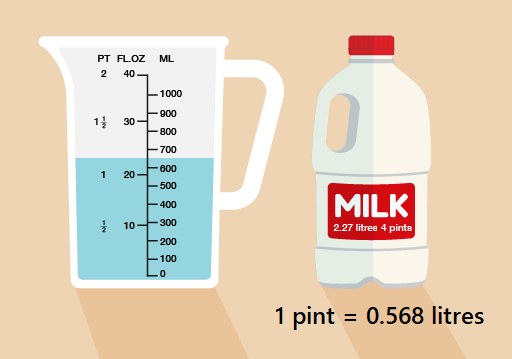In the international system of units, a milliliter (symbol: mL) is a unit of volume that has been accepted for use in the measurement of volume (SI). In volume, one milliliter is equal to one cubic centimeter (cm3), one billion cubic meters (m3), or one-thousandth of a milliliter.
History/Origin: The liter (US spelling), which is spelled “litre” in SI terms, serves as the milliliter’s fundamental unit of measurement. The term “liter” was originally used in the French metric system and was derived from the term “litron,” which was one of the older versions of the French litre. The term “litre” was first used in the English metric system in the mid-19th century. Further information can be found on the litre page.
Currently being used: Throughout everyday life, milliliters (mL) are used to measure the volume of many different types of smaller containers. These include plastic bottles, cans, drinking glasses (including juice and milk cartons), yogurt containers (including tubes of toothpaste), perfume/cologne bottles, and other similar items. In addition to milliliters, many measurement devices, such as graduated cylinders, beakers, pipettes, measurement cups, and so forth, use the unit of milliliters.
Read More: What Time Burger King Lunch Hours
Pint
It is defined as a unit of volume in the imperial and United States customary systems of units, denoted by the symbol p (for a pint). The imperial pint is approximately 568 milliliters (mL) in volume. The liquid pint in the United States is approximately 473 mL, while the dry pint is approximately 551 mL.
History and origin: Historically, both the United States and the United Kingdom defined a pint as 1/8 of a gallon. The distinction between the definitions of pints in the United States and the United Kingdom was first noted in 1824, when the United Kingdom adopted a new definition of the gallon, whereas the United States retained the older English measure of the wine gallon.
Currently in use: The pints, both dry and liquid, are still used as a unit of volume measurement in the United States. Despite the fact that the pint was replaced by metric units of volume as part of the process of metrication, it is still legal to use the pint as a supplementary unit in the United Kingdom, and certain items such as draught beer, cider, and milk in returnable containers are still measured in pints.
Read More: How Many Glasses Of Water Are Included Within A Litre
How Many Millilitres Are In A Pint?
Using different units of measurement is normal when simply following a recipe, as is the case when preparing a meal from scratch. Depending on the recipe you are following, you will be able to find everything from tablespoons to teaspoons, ounces to milliliters, cups to pints, and everything in between. However, in order to ensure that you are using the correct amount of each of the ingredients, you must make certain that you measure them correctly before beginning. It is possible that you will need to make some conversions at some point.
One of the things we know about students is that they are generally uninterested in conversions. The reality is that they are having difficulty attempting to comprehend the relationship between the various units of measurement, and as a result, they are unable to perform conversions correctly. So, hopefully, by the end of today, you will have a clear understanding of how to convert from ounces to pints. After all, when attempting to determine how many mL are in a pint, this information is required.
You should begin by learning more about each of the units of measurement and understanding the relationship between each of them, regardless of whether you are a student or someone who needs to make conversions on a regular basis, such as when baking or cooking. However, the reality is that once you understand how the various measurement units relate to one another, it will be much easier for you to perform conversions. After that, you will notice that it will be much easier to figure out how many mL are in a pint.
So, let’s take a look at each of these units of measurement individually, as well as their relationship to one another and to other units of measurement as a starting point.
Read More: How To Pasaload In Globe And TM
To Convert Milliliters To Pints By Hand, Follow These Steps.
Following on from our previous discussion of the conversion of pints into milliliters – or, more specifically, the question of how many milliliters are in a pint – we will now briefly discuss the conversion of millilitres into pints.
The conversion ratio, just like with the opposite conversion, will need to be examined first, and then a simple math operation will be performed on the results.
If you recall, we already stated that the following:
1 pint is equal to 473.176 milliliters.
In other words, it’s the same as saying:
1 Milliliter is equal to 1 / 473.176 Pints.
1 Milliliter is equal to 0.00211 Pint.
So, let’s look at a real-world illustration.
Consider the following scenario: you wish to convert 20 milliliters to quarts.
Using the conversion ratio between the two units of measurement, you will be able to calculate the distance between them.
1 Milliliter is equal to 0.00211 Pint.
and then perform a straightforward mathematical procedure. If you want to convert 20 milliliters to pints, you can do so by doing one of the following:
20 millilitres = 20 x 0.00211 quarts = 20 millilitres
20 milliliters equals 0.04227 pints (in metric).
As a result, you can say that there are 0.04227 pints in a 20-milliliter container.
Follow Techadvices for the Best of the Technology.

